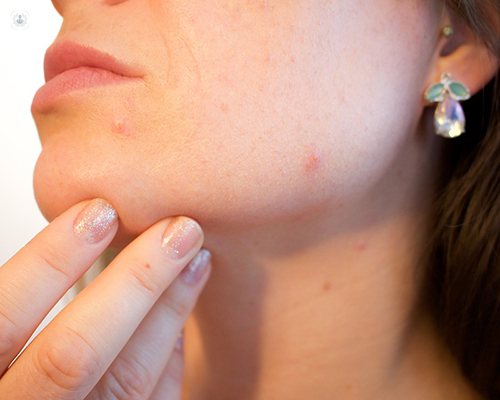

What are skin blemishes?
Human skin is prone to all kinds of spots and stains. Most of the time these are harmless, but it’s important to be able to identify them, to know what they are, and to take action if necessary. Dark stains on the skin are known as hyperpigmentation. Some people may find them distressing if they can’t be hidden or disguised on areas where they tend to appear: the face, hands and other parts exposed to the sun.

Hyperpigmentation occurs when the body produces an excess of melanin in certain areas of the skin. This results in flat patches of skin that have a darker colour, ranging from light brown to black, and which can vary in size and shape. There are many different types, but the most common ones are:
- Pigment stains (such as age spots) à These are small, dark patches caused mainly by exposure to the sun, and therefore appear on exposed areas: face, hands and arms.
- Melasma or chloasma (‘mask of pregnancy’) à Appears in the form of dark, irregular patches on the face or arms. It affects 90% of pregnant women, and women taking the contraceptive pill, due to hormonal changes.
- Inflammatory hyperpigmentation à Appears when a skin injury heals and leaves a flat stain with an altered colour. It is common in people with acne and may also be caused by cosmetic procedures.
Signs of skin stains
The main sign of skin blemishes or patches is a change in the colour of some areas of skin. These are painless, as already mentioned, and can have many causes. They are usually harmless, but a dermatology specialist should take a close look at them nonetheless.
What causes skin stains?
Hyperpigmentation of the skin is the response to an overproduction of melanin (a pigment that gives the skin, hair and eyes their natural colour). Stains on the skin appear in the form of patches and can be triggered by a variety of factors. The most common causes of stains are sun exposure, genetic factors, age, hormonal changes, and skin injury or infection.
Can they be prevented?
Some stains can be prevented, but others are unavoidable. To prevent the appearance of certain stains, you should avoid too much exposure to the sun and should use a high sun protection factor. Any potential hormonal effects caused by medications can be discussed with a specialist.
What does treatment involve?
There are two commonly-used treatments: chemical peel and laser therapy. The former consists of applying an acid solution to the affected area to remove the superficial layers of the skin. The chemical solution causes the skin to blister, and then peel, resulting in the appearance of new, uniform skin. The second treatment, laser therapy, has almost the same effect as the chemical peel but is more precise, since the dermatologist has more control over the procedure. Laser therapy involves ‘hitting’ the affected areas with a high intensity light. Some treatments are mild, acting only on the skin's epidermis or superficial layer, and others are more intense, penetrating the deeper layers of the skin.
Although they are widely used, these treatments are slightly invasive, to a greater or lesser extent depending on your skin type. They may irritate, inflame or burn the skin, causing post-inflammatory hyperpigmentation. New treatments have emerged in recent years using hydroquinone, arbutin, kojic acid, vitamin C derivatives, retinoic acid derivatives, azelaic acid, B-resorcinol or butylresorcinol, as well as jojoba oil or lemon juice, or following a sugar-free diet. All of these are effective ways to treat hyperpigmentation.
